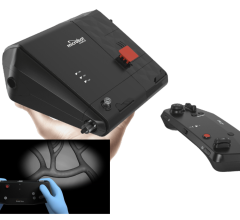
Clinical trial data released during VIVA 2023 Conference included results from a study involving the Veryan Medical BioMimics 3D Vascular Stent System.
November 9, 2023 — The VIVA Foundation, a not-for-profit organization dedicated to advancing the field of vascular medicine and intervention through education and research, announces the results for the last of four Late-Breaking Clinical Trial sessions at the VIVA23 conference, hosted at Wynn Las Vegas.
VIVA (Vascular InterVentional Advances) is an annual vascular education symposium that brings together a global, multispecialty faculty to present a variety of talks and live case presentations from clinical centers around the world. Attendees include an audience of interventional cardiologists, interventional radiologists, vascular surgeons, and endovascular medicine specialists. Below are highlights of this afternoon’s 3 late-breaking clinical trial presentations.
Final Data From the SAFE-DCB US Real-World Multicenter Registry
Presented by: Nicolas Shammas, MD
SAFE-DCB is a prospective, multicenter, single-arm, real-world registry in the United States assessing the clinical use, safety, and outcomes of the Lutonix 035 drug-coated balloon (DCB; BD Interventional) in the superficial femoral and popliteal arteries in a heterogeneous patient population in an on-label clinical use.
A total of 1,005 patients at 74 investigational sites were treated with the Lutonix 035 DCB and were followed to 36 months. The primary effectiveness endpoint was freedom from target lesion revascularization (TLR) at 12 months. The primary safety endpoint was freedom from composite of device- and/or procedure-related perioperative (≤ 30 day) death, target limb major amputation, and target vessel revascularization (TVR). The secondary endpoints were freedom from TVR and TLR post–index procedure, rate of acute device and procedural success, primary patency at 12 months post–index procedure, freedom from composite of all-cause perioperative (≤ 30 day) death and from index limb amputation, reintervention and/or index limb–related death post–index procedure, and freedom from major amputation of the target limb.
Freedom from TLR at 12 months was 88.6%, and freedom from primary safety events at 30 days was 98.2%. At 36 months, freedom from TVR post–index procedure by Kaplan-Meier estimates was 69.5% and freedom from TLR post–index procedure was 74.4%. The rate of acute device and procedural success was 93.0%. Primary patency at 12 months post–index procedure by Kaplan-Meier estimates was 83.7%. Freedom from composite of all-cause perioperative (≤ 30 day) death and from index limb amputation, index limb reintervention, and index limb–related death post–index procedure by Kaplan-Meier estimates at 36 months was 58.4%. Freedom from major amputation of the target limb post–index procedure by proportion-based counts at 36 months was 95.6%.
The results from the SAFE-DCB United States Registry demonstrate an 88.6% and 74.4% freedom from TLR at 12 and 36 months, respectively, and a high degree of safety of the Lutonix 035 DCB in this real-world heterogeneous population.
Compelling 36-Month Outcomes for the BioMimics 3D Stent in TASC-D Lesions: A Subgroup Analysis of the MIMICS-3D EU Registry
Presented by: Robert Beasley, MD, FSIR, FSCAI
Although long-segment femoropopliteal peripheral artery disease (> 200 mm) is common, this population is excluded from nearly all device trials. Traditional straight stents have demonstrated low primary patency in TASC D lesions, with one meta-analysis reporting patency at 1, 2, and 3 years to be 55%, 41%, and 35%, respectively, and only limited 2-year data are available for DES.
BioMimics 3D (Veryan Medical) is a nitinol stent with a unique three-dimensional (3D) helical centerline that provides biomechanical compatibility, promotes swirling blood flow, and beneficially elevates wall shear stress in the stented segment. A post hoc subgroup analysis of the prospective, single-arm, multicenter MIMICS-3D EU registry on patients with TASC-D lesions was conducted.
The MIMICS-3D EU registry enrolled 507 subjects at 23 sites. In the overall intention-to-treat population, the Kaplan-Meier (KM) estimates of freedom from CD-TLR at 1 and 3 years were 89% and 78%, respectively. KM estimates of freedom from loss of primary stent patency (peak systolic velocity ratio > 2.4) at 1 and 3 years were 87% and 70%, respectively.
107 patients presented with TASC D lesions, with a mean lesion length of 273 ± 60 mm, 41% diabetes, 38% severe bilateral wall calcification, and 94% occlusion. The primary safety outcome of freedom from MAE was 98%, and the primary efficacy endpoint demonstrated KM estimates for freedom from CD-TLR of 83% at 12 months and 71% at 36 months. The KM estimates of primary patency were 79% at 12 months and 60% at 36 months. The stent fracture rate at 36 months was 1.9% (2/107).
A subgroup analysis on more complex TASC-D lesions from the MIMICS-3D EU registry supports the hypothesis that imparting a nonplanar curvature nitinol stent design to the femoropopliteal artery to promote swirling blood flow and increase wall shear stress is beneficial and results in 36-month CD-TLR, primary patency, and clinical outcomes that are superior to other treatment options.
Safety and Performance of Percutaneous Transmural Femoropopliteal Bypass With the DETOUR System: Pooled Analysis of DETOUR1 and DETOUR2 Studies
Presented by: Sean Lyden, MD
Percutaneous transfemoral arterial bypass (PTAB) with the Detour system (Endologix LLC) offers an alternative endovascular approach for long-segment, complex superficial femoral artery (SFA) disease. Using this novel approach, the femoral vein becomes the path to bypass the SFA. The Detour system consists of the Torus stent graft and the EndoCross crossing device (both Endologix LLC) to construct a percutaneous bypass. PTAB has the potential to avoid the limitations and complications of traditional open bypass surgery.
Data were aggregated from DETOUR 1 and DETOUR 2, which were prospective, single-arm, multicenter, international studies to evaluate safety and efficacy of the Detour system. Inclusion criteria and prespecified endpoints were similar. Both studies included an imaging core lab and all serious adverse events, including deaths, were adjudicated by a clinical events committee.
Specified endpoints were based on data that were common to both studies. Safety endpoints included freedom from major adverse events (MAEs) through 30 days, symptomatic deep vein thrombosis (DVT), and amputation rates. Efficacy endpoints included primary patency, defined as patency obtained without the need for additional/secondary procedures, and freedom from target vessel revascularization (TVR).
275 patients were enrolled and 273 were treated with the Detour system. Mean age was 68 years, and 23.7% were female. Comorbidities included hypertension (86.5%), diabetes (44%), and renal insufficiency (9.8%). Mean lesion length was 31.6 cm and included 94% chronic total occlusions and 14% in-stent restenotic lesions.
Freedom from MAEs through 30 days was 97.8%. The clinical success rate was 92.9%, 96.0%, and 95.3% at 30 days, 1 year, and 2 years, respectively. Primary patency was 69.2% and freedom from TVR was 68.1% through 2 years. Freedom from symptomatic DVT was 96.7% and the pulmonary embolism rate was 0%, respectively.
DETOUR clinical data demonstrate the clinical utility of this novel therapy in long femoropopliteal lesions. Larger real-world registry data will confirm the generalizability of these findings.
For more information: www.viva-foundation.org


 January 14, 2025
January 14, 2025 







